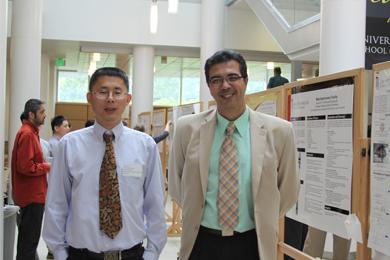School of Pharmacy Hosts Maryland Nanomedicine Day
Day-long symposium aims to promote collaboration among nanomedicine researchers

By Malissa Carroll
July 19, 2013
On July 12, the University of Maryland School of Pharmacy held its Second Maryland Nanomedicine Day, welcoming more than 150 researchers and academicians to the School to share the latest research in the growing field of nanomedicine.
“We held our first Nanomedicine Day in 2006, and back then nanomedicine was a novel concept,” says Bruce Yu, PhD, an associate professor of pharmaceutical sciences at the School who organized the symposium. “Since then, the field of nanomedicine research has progressed and matured. For example, several nanomedicine drugs have gained approval from the Food and Drug Administration (FDA). But with progress there is a demand for more rigorous and substantive research. The time had come to hold another Nanomedicine Day to examine the current status of the field, to reflect, re-examine, and recharge.”
The School of Pharmacy is home to the Center for Nanomedicine and Cellular Delivery, which was established in 2005 and provides expertise and fosters collaborations for the design, development, and use of nanosystems for therapeutic and diagnostic purposes. Nanomedicine research includes the development of diagnostics for rapid monitoring, targeted cancer therapies, localized drug delivery, improved cell material interactions, scaffolds for tissue engineering, and gene delivery systems.
“The Center for Nanomedicine and Cellular Delivery is the scientific collaborative dedicated to exploring and advancing the use of nanosystems in the delivery of bioactive agents for diagnosis and therapy,” says Peter Swaan, PhD, a professor of pharmaceutical sciences and director of the center. “Targeted delivery improves patients’ lives by improving the safety and efficacy of therapeutics and diagnostics. Structures at the nanoscale (a billionth of a meter—not visible by microscopes—but larger than most drug molecules) provide a platform for localized delivery.”
The symposium’s goals were multi-fold: promote collaboration among nanomedicine researchers both within and beyond the University System of Maryland (USM); get non-academic perspectives on nanomedicine research; be an educational vehicle for the School’s pharmacy and graduate students, and promote the nanomedicine research taking place at USM institutions such as the School of Pharmacy, the University of Maryland, College Park, and the University of Maryland Baltimore County.
Speakers represented a variety of universities, institutions, and government agencies, including the FDA, the National Institutes of Health, Yale University and the University of Washington, and CytImmune. They covered topics such as using nanotechnology to change cancer care, transport of nanomedicines across physiological barriers, and systems approach to tissue and cell targeting in nanomedicine.
Jennie Leach, an associate professor of chemical, biochemical, and environmental engineering at the University of Maryland, Baltimore County, presented her research on the study of tissue engineering, “We study how nerve cells live and grow within these materials in order to better understand embryonic development and how to better repair damaged nerves (e.g., stroke, spinal cord injury) and diseases of the nervous system such as Alzheimer’s disease,” says Leach. “I particularly enjoyed connecting with researchers at UMB and local agencies such as NCI and the FDA. We live and work in a community rich with biomedical research and bringing folks together with similar interests in such a well-organized event is a great way to foster new interactions.”
“I enjoyed the exposure to a variety of topics from researchers actively solving real medical problems and moving the field of nanomedicine forward,” says Dianna Campbell, a second-year student pharmacist at the School of Pharmacy. “I felt like I was an observer at the red carpet at some kind of ‘Hollywood’ of science, and I appreciate that this gathering included postgraduates, professors, researchers, and graduate students from various scientific fields.”


